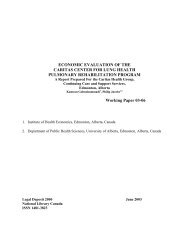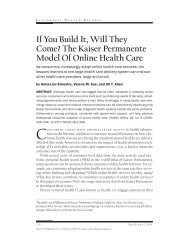Bariatric treatments for adult obesity - Institute of Health Economics
Bariatric treatments for adult obesity - Institute of Health Economics
Bariatric treatments for adult obesity - Institute of Health Economics
- No tags were found...
You also want an ePaper? Increase the reach of your titles
YUMPU automatically turns print PDFs into web optimized ePapers that Google loves.
Rimonabant may be considered <strong>for</strong> patients with dyslipidemia associated with metabolic syndrome(low HDL cholesterol and high triglyceride concentrations) and in patients who are concurrentlyattempting to stop smoking. The drug should be avoided <strong>for</strong> patients with pre-existing majordepressive illness or with liver or kidney function impairment. 4For patients who fail to respond to the anti<strong>obesity</strong> medications—that is, who fail to lose 2 kilogramsafter four weeks or 4 to 5 kilograms after 3 months—drug therapy should be discontinued becauselong-term success is unlikely. 30 In contrast, if the drug is effective it should be continued becausewithdrawal <strong>of</strong> an effective anti<strong>obesity</strong> drug can lead to rapid weight regain and worsening <strong>of</strong> cardiometabolicrisk factors. 30SurgeryDefinition<strong>Bariatric</strong> surgery promotes weight loss primarily through gastric restriction and intestinal diversion. 31Some procedures contain both restriction and diversion elements. In addition to structural alteration<strong>of</strong> the gastrointestinal tract, bariatric surgery may also influence the levels <strong>of</strong> the gut hormones thatare involved in energy regulation. 32Brief historySince the introduction <strong>of</strong> bariatric surgery in the 1950s, various surgical procedures have beendeveloped and have undergone continuing modification and refinement. 33 Minimally invasivelaparoscopic surgery became the technique <strong>of</strong> choice in the 1990s. 33Types<strong>Bariatric</strong> surgeries can be divided into three categories:(1) restrictive—producing weight loss by limiting the amount <strong>of</strong> food ingested(2) mal-absorptive—producing weight loss by limiting the amount <strong>of</strong> nutrient absorbed(3) mixed—producing weight loss through both mechanisms 34,35Several commonly per<strong>for</strong>med surgical procedures are listed in Table T.4. <strong>Bariatric</strong> surgeries can beper<strong>for</strong>med by either open or laparoscopic approaches; currently, most bariatric procedures are beingper<strong>for</strong>med laparoscopically. 36 Gastric bypass and laparoscopic adjustable gastric banding (LAGB) arethe most commonly per<strong>for</strong>med procedures internationally. Sleeve gastrectomy is a new treatmentthat is gaining popularity, 37 whereas vertical banded gastroplasty, jejunoileal bypass, and minigastricloop bypass have been abandoned. 38,39Table T.4: <strong>Bariatric</strong> surgeryProcedureadjustable gastric bandingvertical banded gastroplastysleeve gastrectomyRoux-en-Y gastric bypassbiliopancreatic diversion with duodenal switchbiliopancreatic diversionSource: Fried et al, 2007 33,34,40Mechanism <strong>of</strong> actionrestrictiverestrictiverestrictiverestrictive and mal-absorptive (mixed)restrictive and mal-absorptive (mixed)mal-absorptive<strong>Bariatric</strong> <strong>treatments</strong> <strong>for</strong> <strong>adult</strong> <strong>obesity</strong> 70
















